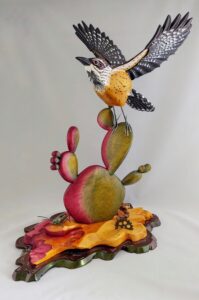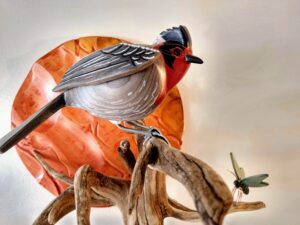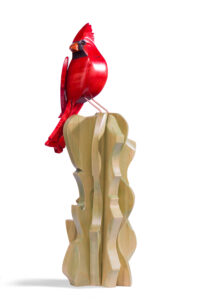Whittling Wonders

Ray Richardson’s Avian Artistry Takes Flight at Hidden in the Hills
Writer Susan Kern-Fleischer
In a sun-drenched studio in Phoenix, Ray Richardson’s skilled hands dance across a block of maple, coaxing the form of a cactus wren from the wood. With each precise cut, the bird seems poised to take flight, capturing the essence of Arizona’s rugged beauty. This masterful piece, “Island,” is more than just a sculpture — it’s the face of this year’s Hidden in the Hills Artist Studio Tour, a testament to the vibrant artistic community thriving in the Desert Foothills.
Arizona’s largest and longest-running artist studio tour, Hidden in the Hills, returns to the Desert Foothills community for its 28th year during the last two weekends of November. Coordinated by the nonprofit Sonoran Arts League, this year’s free, self-guided tour features 179 artists at 44 studios throughout Cave Creek, Carefree and North Scottsdale.
Showcasing both nationally recognized and emerging artists, the popular art tour attracts thousands of patrons who appreciate fine art and seek a variety of mediums, styles and price ranges. With the event taking place the weekends before and after Thanksgiving, the tour also attracts holiday shoppers who want to find an original, unique gift.



Chosen to grace the front cover of this year’s artist directory, Richardson’s “Island” depicts a cactus wren starting to leap into the air from a prickly pear cactus.
“Ray’s piece is so unique,” says Gail Haire, a longtime HITH participant and highly acclaimed oil painter who serves as the event’s co-chair. “His workmanship is outstanding, and we were drawn to the intensity of colors, both on the bird and the cactus. Ray specializes in carving birds from wood, and his full body of work is remarkable. This is his first year participating in Hidden in the Hills, and we’re thrilled to feature ‘Island’ on this year’s artist directory cover.”
Growing up in Northwest Connecticut, Richardson was enthralled with birds at a young age. He loved spending time outdoors, and his grandmother fueled his interest through nature books and magazines. She also introduced him to comic books, where he was captivated by the idea of using lines, shapes and colors to tell stories. Later, after serving in the Navy, Richardson attended community college and found his passion for fine art. While he excelled in oil painting, he began working in carpentry, which opened the door to woodworking.
He began carving birds in the early 2000s while working outside on a client’s project.
“The property had a beautiful garden filled with hummingbirds, and they would buzz me as I was carving,” Richardson recalls. “I was so enthralled that I started wondering if I could capture the moment in wood. I believe that was the catalyst moment for me.”



Carving birds from wood seemed natural for Richardson, particularly since some of his earliest childhood drawings were of birds.
“I think that wood is very well-suited for the avian form,” he explains. “Their aerodynamic characteristics can be quite elegant, maybe even deceptively simple. I think there’s also something about the space that they occupy that makes them a compelling subject. Birds live in this liminal space between heaven and earth. I think that fuels human imagination in ways both scientific as well as mythic.”
His favorite birds are swallows, particularly barn swallows. Their colors, dynamism and ties to human beings check all the boxes of interest for him.
When Richardson moved to Arizona in 2015, he began including landscape elements in his bird sculptures.
“Part of the excitement of moving to Arizona was experiencing a new landscape drastically different from New England’s,” he reflects. “Learning about and interacting with the flora and fauna, particularly the birds, is still a huge part of the adventure and renewed inspiration in my work. I don’t do much photography, but I keep a notebook about experiences. I had been sculpting birds for some years back East, but I think that a change can be seen in my work after the move to the desert. I started to include the landscape as well as materials, such as cholla rib and manzanita root, for example.”



He enjoys working with domestic hardwoods such as maple, cherry and walnut. Beyond their raw beauty, he likes the way these species shape, sand and take finish.
“Woodworking engages ‘both sides of my brain,’” he notes. “Some of the process is very technical and mathematic, but there’s also lots of room for intuitive exploration and spontaneous play. I feel that wood is kind of like a collaborator with input into the creative process. The figure, grain and anomalies of the lumber often suggest how the material is going to be utilized. Sometimes these qualities inspire me to do something different above and beyond my original intentions.”
With each bird he sculpts, he endeavors to capture the humor, whimsy and wonder that he experiences in the world and to express it in a way that is unique but relatable. He especially likes the challenge of capturing a bird’s movement.
“Wood is essentially a rigid sponge, susceptible to changes in humidity, and that’s always something that I am mindful of, even here in the desert,” he points out. “One of the ongoing learning experiences is how to fasten complicated pieces together. Capturing movement in a piece is definitely a more involved project than sculpting a perched bird looking straight ahead. I attempt to work out as much as I can on paper, but it can be a real process when attempting to translate the two-dimensional into 3D.”



Richardson’s “Island” measures 15 inches wide by 9 inches deep by 19.75 inches high. Much of the piece is made of maple, including the base. His initial inspiration came from encountering cactus wrens shortly after moving to Arizona. He sketched his ideas, but it wasn’t until years later, during the pandemic, that he began sculpting “Island.”
“As I was working on the piece, the shape of the base suggested the idea of a landmass to me,” muses Richardson, who will be exhibiting and selling his work at Roxanne Eklund’s Studio No. 31 in Cave Creek during this year’s tour. “That visual idea blended with the deep isolation of those days. I would look out of my garage while I was carving and see my neighborhood…somehow the houses across the street seemed so far away. I think that the wren leaping from the cactus signified my desire to connect with a world that was still turning as it always had, but felt remote.”
28th Annual Hidden in the Hills Artist Studio Tour
Nov. 22–24 and Nov. 29–Dec. 1 // 10 a.m.–5 p.m. // See website for participating studios // Free // hiddeninthehills.org

